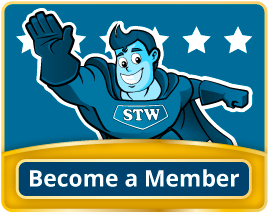2nd Grade Common Core: RI.2.6
Common Core Identifier: RI.2.6 / Grade: 2
Curriculum: Reading Informational: Craft and Structure
Detail: Identify the main purpose of a text, including what the author wants to answer, explain, or describe.
19 Common Core State Standards (CCSS) aligned worksheets found:
This basic article teaches kids about groundhog burrows, hibernation, and habitats. Includes comprehension questions, a vocabulary matching activity, and a writing prompt.
[Approx. Grade Levels: 1-2]
[Approx. Grade Levels: 1-2]
Level:
Filing Cabinet
Logged in members can use the Super Teacher Worksheets filing cabinet to save their favorite worksheets.
Quickly access your most used files AND your custom generated worksheets!
Please login to your account or become a member and join our community today to utilize this helpful feature.
Insects have no backbones, three main body parts, and six legs. These three paragraphs and paired questions explore what makes an insect an insect.
Level:
Snakes FREE
Read and learn about snakes with this science poem. Students will enjoy discovering why snakes stick their tongue out as they slither along.
Level:
This reading comprehension article is written at a second-grade level about the adorable squirrel monkey. The worksheet includes a vocabulary activity and writing prompt, along with both multiple choice and short answer comprehension questions.
Level:
This short reading has been tailored for younger kids who are interested in learning about our solar system's star! Read the four paragraphs and then answer the four questions.
Level:
This short article gives students an overview of what makes a weather event a blizzard. It also includes four reading comprehension questions.
Level:
Your students might be amazed to learn that it can be day all night and night all day in some parts of the world! This nonfiction passage explains how day and night are made.
Level:
Learn all about the bat with the misleading name with this engaging article. Accessible text and eye-catching photos help students understand key concepts and answer the reading comprehension questions.
Level:
The Ankylosaurus was a heavy, armored, plant-eating dinosaur from the Late Cretaceous period. It was known for its clubbed tail.
Level:
The Pteranodon was a giant, flying lizard that lived in the late Cretaceous period. It probably ate fish, crabs, squid, and dead animals.
Level:
The Stegosaurus was a large, plant-eating dinosaur that lived in the Late Jurassic period. It had large spikes on its tail to fight predators.
Level:
Discover one of the largest and meanest meat-eating dinosaurs. Did you know a t-rex had 60 sharp teeth, and each one is the size of a banana?
Level:
Cut out the names and pictures of six dinosaurs. Then categorize them into two groups - carnivores and herbivores. Then glue them onto the graphic organizer.
Level:
The Brachiosaurus was one of the largest dinosaurs. It had a long neck and was twice as tall as a giraffe. This plant-eater had no real predators.
Level:
Did you know that the Velociraptor was a dinosaur that was covered in feathers? Learn all about raptors with this informative article.
Level:
The Spinosaurus was a gigantic meat-eating dinosaur that was even larger than T-rex. It had a crocodile-shaped snout with sharp teeth for eating fish.
Level:
The Triceratops is very similar to the modern day rhinoceros. They both had large bodies, ate plants, and had horns on their heads. The triceratops was ten feet long and weighed as much as two elephants.
Level:
Students choose a dinosaur species and research its size, weight, habitat, and other interesting information.
Level:










